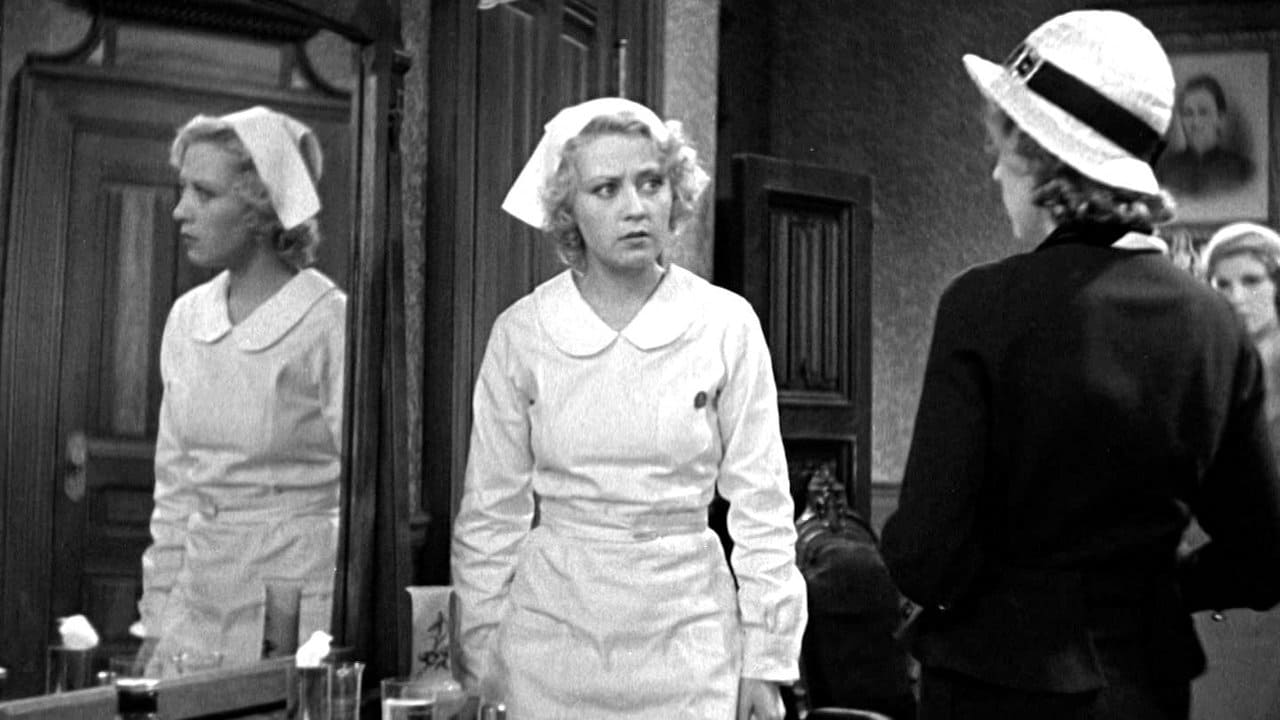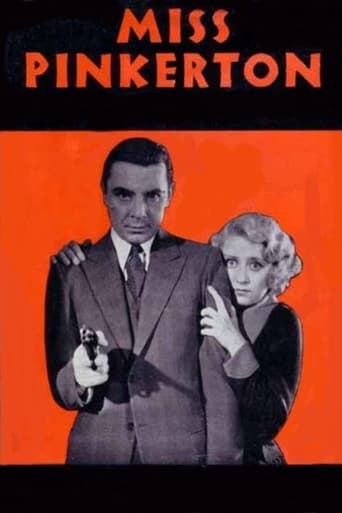Unlimitedia
Sick Product of a Sick System
VeteranLight
I don't have all the words right now but this film is a work of art.
Phonearl
Good start, but then it gets ruined
InformationRap
This is one of the few movies I've ever seen where the whole audience broke into spontaneous, loud applause a third of the way in.
Richard Chatten
Early on in this pre-Code murder mystery the gorgeous Joan Blondell laments the monotony of her existence as a nurse and asks how it can be relieved; promptly answering her own question as far as the audience is concerned by immediately shedding her uniform and slipping down to her scanties.But she soon gets enough excitement to last her a lifetime when sent to tend to a wealthy woman whose nephew has just been shot dead under suspicious circumstances (we see a remarkably realistic-looking police photograph of the corpse at one point). Based on a novel by Mary Roberts Rinehart, there's an awful lot of talk, and new characters keep showing up making the story harder to follow without making things any more interesting (the final denouement was so complicated and so laboriously explained verbally that I've already forgotten whodunit despite having seen it only a couple of hours ago).Director Lloyd Bacon and cameraman Barney McGill go out of their way to compensate for the general lack of action by including a lot of creeping about in the shadows and by smothering Jack Okey's magnificent Old Dark House set in eye-boggling compositions juggling weird camera angles and deep focus. John Wray as Hugo the butler is so relentlessly photographed on the tilt throughout the film to make him look sinister (not to mention constantly exchanging shifty glances with housekeeper Blanche Friderici) that we know he can't possibly be guilty; while Elizabeth Patterson as the matriarch on her deathbed looks dramatically different from anything else I've ever seen her in. The most remarkable single shot in the entire film is probably one of Blondell and George Brent sliding out of focus and into darkness as seen from the point of view of a character whose life is slipping away; although throughout the whole film the frequent close ups of Blondell are always more than enough to revive interest if things start to flag.
tedg
This era in filmmaking is fascinating. The evolution of the medium was in a phase of punctuation where everything was up for grabs and narrative conventions we now take for granted were formed. Watching these is like exploring the Burgess Shale, to see elements that lasted, and many that didn't.The story here nominally has a young nurse planted in a house to solve a murder. This is a typical spooky large house, with a bedridden cranky old person. Not every suspect is locked in the house, living there, but they all are presented within the building. Some of them are caught sneaking about, but are seen from a window. There are relatives, lovers, the doctor and lawyer. Newspapermen sometimes hover. The nurse is a blond who wants excitement and finds it in a romance with the detective. As this is pre-code, we are introduced to her character as she is getting ready for bed.Along the way are numerous narrative devices that are hard to even notice today. It just seems off, but that is because what we are watching for is different. One of these is Blondell getting grabbed in the dark by a menacing silhouette. She screams persistently, long enough for doors to be battered down. This happens three time. The plot is so complicated, it by three different men. There seems to be no reason for her to be grabbed so, other than to reference common fears of the women in the audience — and fantasy of the men? The solution to the mystery is revealed to a gathering of the suspects. It is more complicated than usual, so much so that it does not tie up all the ends, nor completely explain what we have seen.Ted's Evaluation -- 1 of 3: You can find something better to do with this part of your life.
calvinnme
...specifically between Joan Blondell and George Brent. These are two players whose performances and films I generally enjoy immensely, but here the two just seem to be acting at each other rather than with each other. It's hard to describe unless you actually see it.Blondell plays a nurse in a hospital - Nurse Adams - who is bored with hospital routine. One night she gets picked by the head nurse to be private nurse for the night to an old woman who has had a terrible shock - the old woman found the body of her nephew shortly after he had been shot with his own gun. Was it suicide? Was it murder? If it was murder, what was the motive? These are the questions surrounding the mystery of the unnatural death of Herbert Wynn. There is also the complication of Herbert Wynn's life being insured for one hundred thousand dollars payable to his aunt, and that his family - once wealthy - is now on the verge of bankruptcy and ruin. So, there is just as much a motive for making the suicide look accidental - or like a murder - as there is reason for making any murder that has occurred look like a suicide or accident. Life insurance doesn't pay out for suicide.Enter George Brent, a police detective on the case that takes an immediate liking to Nurse Adams and dubs her "Miss Pinkerton". I could never really figure that one out, unless it has something to do with the famous Scottish detective whose name is often a pseudonym for detective. This is really an old dark house tale mixed in with elements of the Thin Man. From the old dark house side of things we have a creepy mansion with creepier inhabitants and mysterious locked rooms. From the Thin Man tradition of mysteries - which actually wasn't made for two years after this film - we have everybody shooting darting and knowing glances at everyone else and looking guilty and somewhat conspiratorial.The rather complex plot will keep you interested, but you'll likely be disappointed with the romance and partnership end of things between Blondell and Brent. They were both capable of having tremendous chemistry with other leading ladies and men, just not with each other and certainly not in this film. Recommended, but with reservations.
eschetic-2
By the time MISS PINKERTON was made, Hollywood was starting to repeat themselves in their treatments of Mary Roberts Rinehart (first purveyor of the "little old lady detective" that Agatha Christie would perfect with her Miss Marple and Angela Lansbury would do to a fare thee well in her Jessica Fletcher character) and the stage based sets for their "old dark house" mysteries. From the very first shots of MISS PINKERTON, with long shadows cast on the facade of the house in question where murder is to be done (and done again?), we're back in the territory of THE BAT (aka The Spiral Staircase), Ms. Rinehart's most successful stage and film excursion.As before, we have Ms. Rinehart's feisty "little old lady," Elizabeth Patterson as Juliet Mitchell, accompanied by a comic companion (in this case Nurse Adams played by Joan Blondell) and a host of potential suspects in her mysterious (and enormous) old house, but as film making technique has progressed in only a few years of sound (and Ms. Rinehart knew when to vary a successful template), this time we have a fun twist in casting the young comedienne as the lead and assistant to the fresh faced detective (George Brent as Inspector Patten on his "first case"), and the old lady as one of the potential suspects, thought to pass off a suicide as murder for the insurance money . . . or was it murder after all?Blondell is at her youthful best, and the studio cast is crammed full of first class talent on their way up from C. Henry Gordon as Dr. Stuart to the briefest of shots of a young Walter Brennan as a Police Dispatcher at the beginning.Modern action buffs may sniff that the atmospheric tale seems at times to be more about the enormous, detailed sets than the mystery itself, with unidentified characters sneaking in and up long back staircases, women screaming and the odd comic set piece (is the dog a clue?), but director Lloyd Bacon (the silent film actor turned director who had shepherded Cole Porter's 50 MILLION FRENCHMAN to the screen the year before with members of the Broadway cast but without Porter's songs and would mount the classic 42ND STREET *with* songs the next year, continuing to work into the 1950's!) keeps the action spinning for the barely hour (six minutes over) running time.Bask in the details of life in the early depression era (before the details of life outside got too depressing) and have the good time this nicely layered film offers, seeing if you can keep the suspects and motivations straight even when murder is committed right in front of your eyes - and remember "it ain't over 'till it's over," and that isn't when it first appears!

